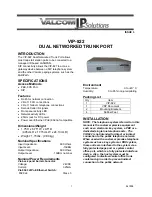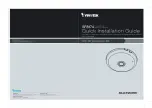
Battery Reversal FXS & Dial Pulse Origination Card
9-16
9/24/01
provides twelve 2-wire CPE analog loop-start connections to the digital T1 line using the same
method used by the FXS voice card, only with the addition of Tip/Ring battery reversal. The FXS
interface reverses the polarity of the battery feed towards the customer premise equipment (CPE) in
response to the signaling bits coming from the T1 line. Various PBX systems require battery reversal
to signal the start of billing, and in certain telephony environments it is needed to provide Line Side
Answer Supervision (LSAS). One important application for battery reversal occurs in International
Call Back, which allows international callers dialing the US to avoid more expensive inbound rates
by taking advantage of cheaper US outbound long distance rates.
Dial Pulse Origination (DPO) is the functional complement to Dial Pulse Termination (DPT) pro-
vided by the FXO/DPT voice card. Used in conjunction, the DPO and DPT cards are used mainly for
origination and termination of Direct Inward Dial (DID) circuits.
The BRFXS/DPO is a 7.8” by 13.16” daughter card designed to slide into the back of the Access
Bank II along rails that guide a 64-pin DIN connector to mate with a matched connector on the inter-
nal ABI Controller. The card receives the T1 signaling, tip and ring pairs, control logic and power
from the Controller card through this connector. The back plate of the card has 12 channel status
LEDs and one 4-position DIP switch for selecting between battery reversal FXS loop-start and Dial
Pulse Originating (DPO) modes of operation. Furthermore, the back plate also contains 12 test
switches that can be used to “busy out” each channel individually. On the BRFXS/DPO card itself,
each individual channel has a 6-position DIP switch for setting transmit and receive line attenuation.
9.3 Overview of Operation
The reversible-battery FXS channel card is designed to provide twelve 2-wire analog interfaces to the
digital T1 (DS1) line. Currently, the analog loops (also called CPE loops in this document) must
always be loop-start.
One of the main features of the analog interface is that the polarity of the battery feed towards the
customer-premise equipment (CPE) can be reversed in response to the signaling bits coming from the
T1 line.
•
The basic operation is selected by setting Switch A
off
so that no ringing voltage is
applied towards the CPE. If desired, Switch B can be turned
on
to give a cadenced (2-
second/4-second) ringback tone to the T1 line during incoming calls. The battery to the
CPE loop will be reversed to indicate an incoming call. The battery will return to forward
polarity again when the call has ended.
•
Also included in this channel card is a setting to provide cadenced ringing voltage (if
needed by other customer-premise equipment). This option is enabled by setting Switch
A
on
so that cadenced ringing voltage will be applied to the CPE loop during an incom-
ing call. The battery is reversed during this time. If desired, Switch B can be turned
on
to
give a cadenced (2-second/4-second) ringback tone to the T1 line during incoming calls,
that is synchronized to the ringing voltage present on the loop.
Содержание Access Bank II SNMP
Страница 17: ...xx ...
Страница 37: ...3 8 9 24 01 ...
Страница 47: ...4 10 9 24 01 ...
Страница 61: ...5 14 9 24 01 ...
Страница 69: ...6 8 9 24 01 ...
Страница 87: ...FXS ID Configuration 8 14 9 24 01 ...
Страница 97: ...Battery Reversal FXS Dial Pulse Origination Card 9 24 9 24 01 ...
Страница 103: ...12 Channel FXO Dial Pulse Termination Card 10 6 9 24 01 ...
Страница 121: ...4 Wire E M TO Configuration 11 18 9 24 01 ...
Страница 139: ...12 18 9 24 01 ...
Страница 144: ...Replacing the Controller Card 9 24 01 13 5 Figure 13 3 Replacing the Controller Card ...
Страница 145: ...13 6 9 24 01 ...
















































